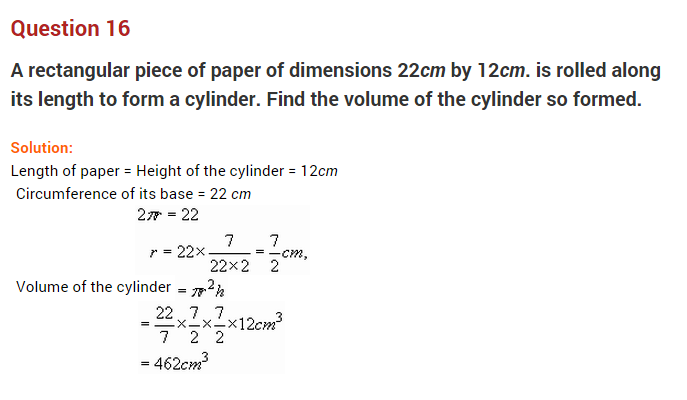NCERT Solutions for Class 8 Maths Chapter 11 Mensuration
NCERT Solutions for Class 8 Maths Chapter 11 Mensuration Exercise 11.1
Ex 11.1 Class 8 Maths Question 1.
A square and a rectangular field with measurements as given in the figure have the same perimeter. Which field has a larger area?
Solution:
Perimeter of figure (a) = 4 × side = 4 × 60 = 240 m
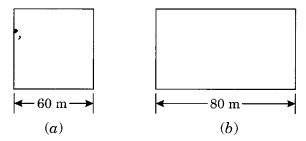
Perimeter of figure (b) = 2 [l + b]
Perimeter of figure (b) = Perimeter of figure (a)
2[l + b] = 240
⇒ 2 [80 + b] = 240
⇒ 80 + b = 120
⇒ b = 120 – 80 = 40 m
Area of figure (a) = (side)2 = 60 × 60 = 3600 m2
Area of figure (b) = l × b = 80 × 40 = 3200 m2
So, area of figure (a) is longer than the area of figure (b).
Ex 11.1 Class 8 Maths Question 2.
Mrs Kaushik has a square plot with the measurement as shown in the figure. She wants to construct a house in the middle of the plot. A garden is developed around the house. Find the total cost of developing a garden around the house at the rate of ₹ 55 per m2.
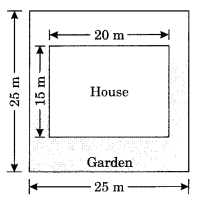
Solution:
Area of the plot = side × side = 25 m × 25 m = 625 m2
Area of the house = l × b = 20 m × 15 m = 300 m2
Area of the garden to be developed = Area of the plot – Area of the house = 625 m2 – 300 m2 = 325 m2
Cost of developing the garden = ₹ 325 × 55 = ₹ 17875
Ex 11.1 Class 8 Maths Question 3.
The shape of a garden is rectangular in the middle and semicircular at the ends as shown in the diagram. Find the area and the perimeter of this garden. [Length of rectangle is 20 – (3.5 + 3.5) metres]
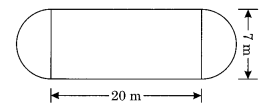
Solution:
Length of the rectangle = 20 – (3.5 + 3.5) = 20 – 7 = 13 m
Area of the rectangle = l × b = 13 × 7 = 91 m2
Area of two circular ends = 2(12 πr2)
= πr2
= 227 × 72 × 72
= 772 m2
= 38.5 m2
Total area = Area of the rectangle + Area of two ends = 91 m2 + 38.5 m2 = 129.5 m2
Total perimeter = Perimeter of the rectangle + Perimeter of two ends
= 2 (l + b) + 2 × (πr) – 2(2r)
= 2 (13 + 7) + 2(227 × 72) – 4 × 72
= 2 × 20 + 22 – 14
= 40 + 22 – 14
= 48 m
Ex 11.1 Class 8 Maths Question 4.
A flooring tile has the shape of a parallelogram whose base is 24 cm and the corresponding height is 10 cm. How many such tiles are required to cover a floor of area 1080 m2? (If required you can split the tiles in whatever way you want to fill up the corners).
Solution:
Area of the floor = 1080 m2 = 1080 × 10000 cm2 = 10800000 cm2 [∵ 1 m2 = 10000 cm2]
Area of 1 tile = 1 × base × height = 1 × 24 × 10 = 240 cm2
Number of tiles required
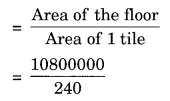
= 45000 tiles
Ex 11.1 Class 8 Maths Question 5.
An ant is moving around a few food pieces of different shapes scattered on the floor. For which food-piece would the ant have to take a longer round? Remember, the circumference of a circle can be obtained by using the expression C = 2πr, where r is the radius of the circle.
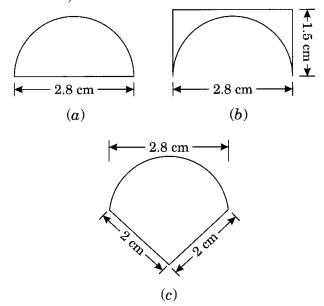
Solution:
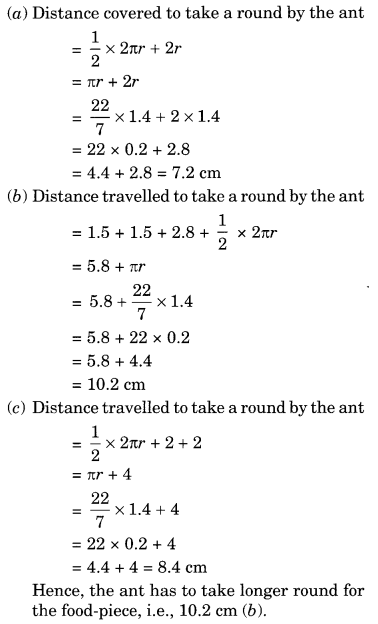
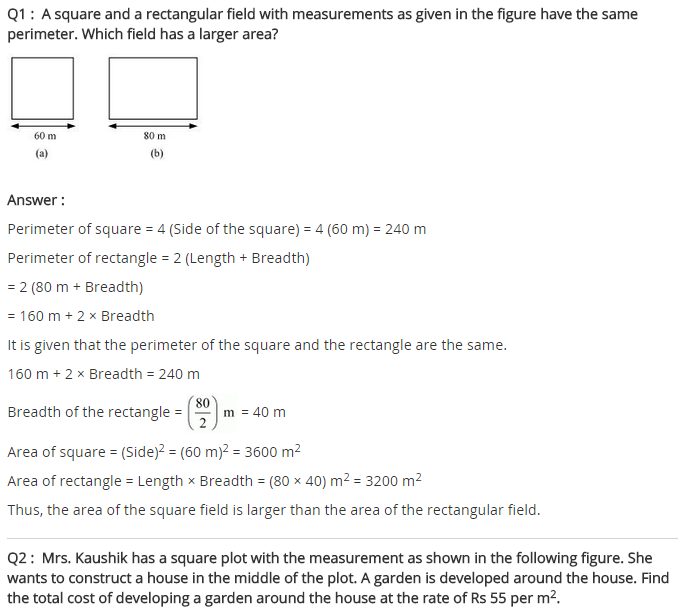
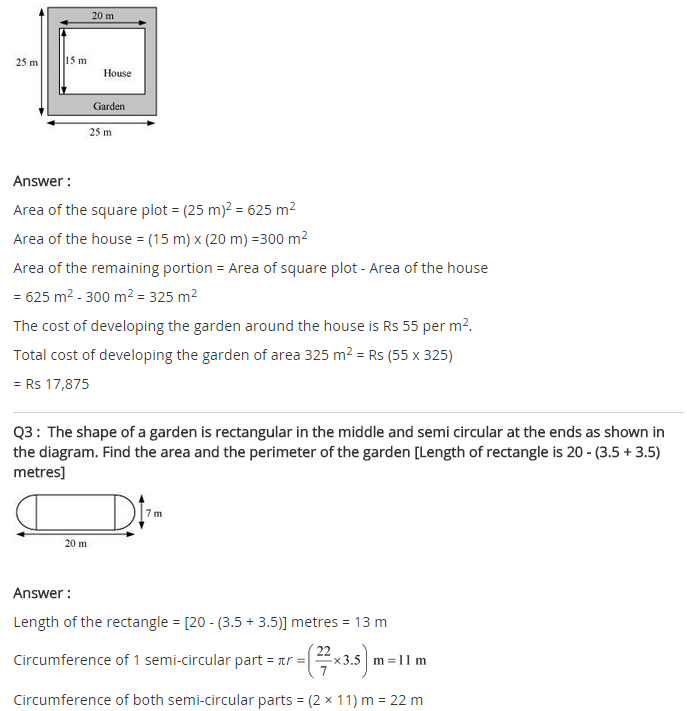
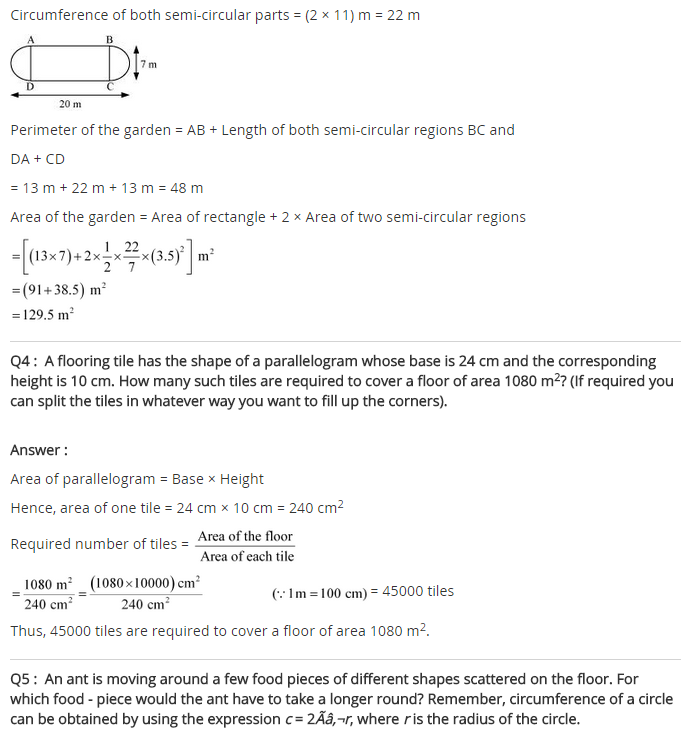
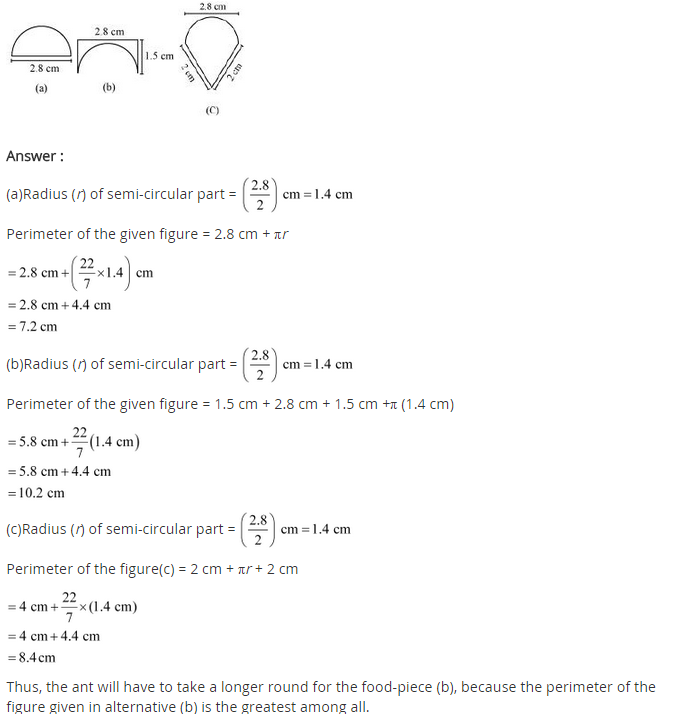
NCERT Solutions for Class 8 Maths Chapter 11 Mensuration Exercise 11.2
Ex 11.2 Class 8 Maths Question 1.
The shape of the top surface of a table is a trapezium. Find its area if its parallel sides are 1 m and 1.2 m and perpendicular distance between them is 0.8 m.
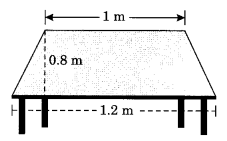
Solution:
Area of the trapezium = 12 × (a + b) × h
= 12 × (1.2 + 1) × 0.8
= 12 × 2.2 × 0.8
= 0.88 m2
Hence, the required area = 0.88 m2
Ex 11.2 Class 8 Maths Question 2.
The area of a trapezium is 34 cm2 and the length of one of the parallel sides is 10 cm and its height is 4 cm. Find the length of the other parallel sides.
Solution:
Given: Area of trapezium = 34 cm2
Length of one of the parallel sides a = 10 cm
height h = 4 cm
Area of the trapezium = 12 × (a + b) × h
34 = 12 × (10 + b) × 4
⇒ 34 = (10 + b) × 2
⇒ 17 = 10 + b
⇒ b = 17 – 10 = 7 cm
Hence, the required length = 7 cm.
Ex 11.2 Class 8 Maths Question 3.
Length of the fence of a trapezium-shaped field ABCD is 120 m. If BC = 48 m, CD = 17 m and AD = 40 m, find the area of this field. Side AB is perpendicular to the parallel sides AD and BC.
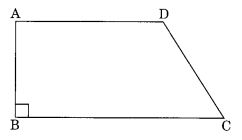
Solution:
Given:
AB + BC + CD + DA = 120 m .
BC = 48 m, CD = 17 m, AD = 40 m
AB = 120 m – (48 m + 17 m + 40 m) = 120 – 105 m = 15 m
Area of the trapezium ABCD = 12 × (BC + AD) × AB
= 12 × (48 + 40) × 15
= 12 × 88 × 15
= 44 × 15 = 660 m2.
Hence, the required area = 660 m2
Ex 11.2 Class 8 Maths Question 4.
The diagonal of a quadrilateral shaped field is 24 m and the perpendiculars dropped on it from the remaining opposite vertices are 8 m and 13 m. Find the area of the field.
Solution:
Area of the field = area of ∆ABD + area of ∆BCD
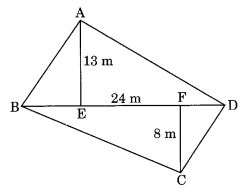
= 12 × b × h + 12 × b × h
= 12 × 24 × 13 + 12 × 24 × 8
= 12 × 13 + 12 × 8
= 12 × (13 + 8)
= 12 × 21
= 252 m2
Hence, the required area of the field = 252 m2.
Ex 11.2 Class 8 Maths Question 5.
The diagonals of a rhombus are 7.5 cm and 12 cm. Find its area.
Solution:
Here, d1 = 7.5 cm, d2 = 12 cm
Area of the rhombus = 12 × d1 × d2
= 12 × 7.5 × 12
= 7.5 × 6
= 45 cm2
Hence, area of the rhombus = 45 cm2.
Ex 11.2 Class 8 Maths Question 6.
Find the area of a rhombus whose side is 5 cm and whose altitude is 4.8 cm. If one of its diagonals is 8 cm long, find the length of the other diagonal.
Solution:
Given: Side = 5 cm
Altitude = 4.8 cm
Length of one diagonal = 8 cm
Area of the rhombus = Side × Altitude = 5 × 4.8 = 24 cm2
Area of the rhombus = 12 × d1 × d2
24 = 12 × d1 × d2
24 = 4d2
d2 = 6 cm
Hence, the length of other diagonal = 6 cm.
Ex 11.2 Class 8 Maths Question 7.
The floor of a building consists of 3000 tiles which are rhombus shaped and each of its diagonals are 45 cm and 30 cm in length. Find the total cost of polishing the floor, if the cost per m2 is ₹ 4.
Solution:
Given: Number of tiles = 3000
Length of the two diagonals of a tile = 45 cm and 30 cm
Area of one tile = 12 × d1 × d2
= 12 × 45 × 30
= 45 × 15
= 675 cm2
Area covered by 3000 tiles = 3000 × 675 cm2 = 2025000 cm2 = 202.5 m2
Cost of polishing the floor = 202.5 × 4 = ₹ 810
Hence, the required cost = ₹ 810.
Ex 11.2 Class 8 Maths Question 8.
Mohan wants to buy a trapezium-shaped field. Its side along the river is parallel to and twice the side along the road. If the area of this field is 10500 m2 and the perpendicular distance between the two parallel sides is 100 m, find the length of the side along the river.
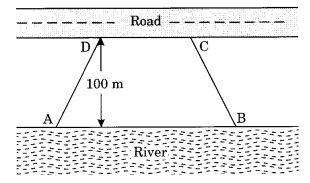
Solution:
Let the side of the trapezium (roadside) be x cm.
The opposite parallel side = 2x m
h = 100 m
Area = 10500 m2
Area of trapezium = 12 (a + b) × h
10500 = 12 (2x + x) × 100
2 × 10500 = 3x × 100
21000 = 300x
x = 70 m
So, AB = 2x = 2 × 70 = 140 m
Hence, the required length = 140 m.
Ex 11.2 Class 8 Maths Question 9.
The top surface of a raised platform is in the shape of a regular octagon as shown in the figure. Find the area of the octagonal surface.
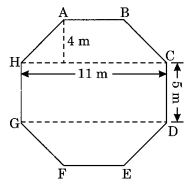
Solution:
Area of the octagonal surface = area of trapezium ABCH + area of rectangle HCDG + area of trapezium GDEF
Area of trapezium ABCH = Area of trapezium GDEF
= 12 (a + b) × h
= 12 (11 + 5) × 4
= 12 × 16 × 4
= 32 m2
Area of rectangle HCDG = l × b = 11 m × 5 m = 55 m2
Area of the octagonal surface = 32 m2 + 55 m2 + 32 m2 = 119 m2
Hence, the required area = 119 m2.
Ex 11.2 Class 8 Maths Question 10.
There is a pentagonal shaped park as shown in the figure. For finding its area Jyoti and Kavita divided it in two different ways.
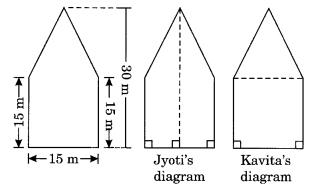
Find the area of this park using both ways. Can you suggest some other way of finding its area?
Solution:
(i) From Jyoti’s diagram:
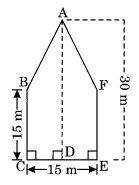
Area of the pentagonal shape = Area of trapezium ABCD + Area of trapezium ADEF
= 2 × Area of trapezium ABCD
= 2 × 12 (a + b) × h
= (15 + 30) × 7.5
= 45 × 7.5
= 337.5 m2
(ii) From Kavita’s diagram:
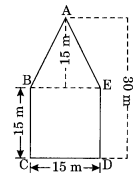
Area of the pentagonal shape = Area of ∆ABE + Area of square BCDE
= 12 × b × h + 15 × 15
= 12 × 15 × 15 + 225
= 112.5 + 225
= 337.5 m2
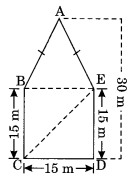
Yes, we can also find the other way to calculate the area of the given pentagonal shape.
Join CE to divide the figure into two parts, i.e., trapezium ABCE and right triangle EDC.
Area of ABCDE = Area of ∆EDC + Area of square ABCE
Ex 11.2 Class 8 Maths Question 11.
Diagram of the picture frame has outer dimensions = 24 cm × 28 cm and inner dimensions 16 cm × 20 cm. Find the area of each section of the frame, if the width of each section is the same.
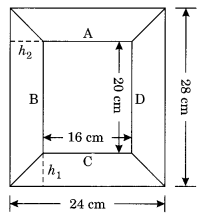
Solution:
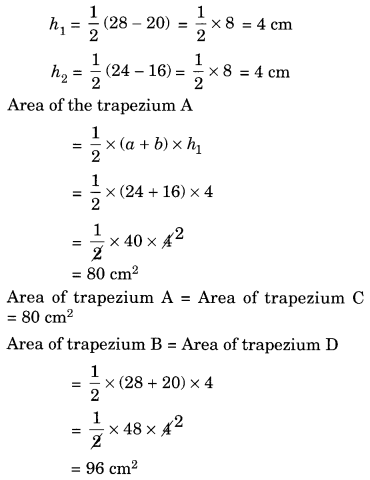
Hence, the areas of the four parts A, B, C, and D are 80 cm2, 96 cm2, 80 cm2, and 96 cm2 respectively.
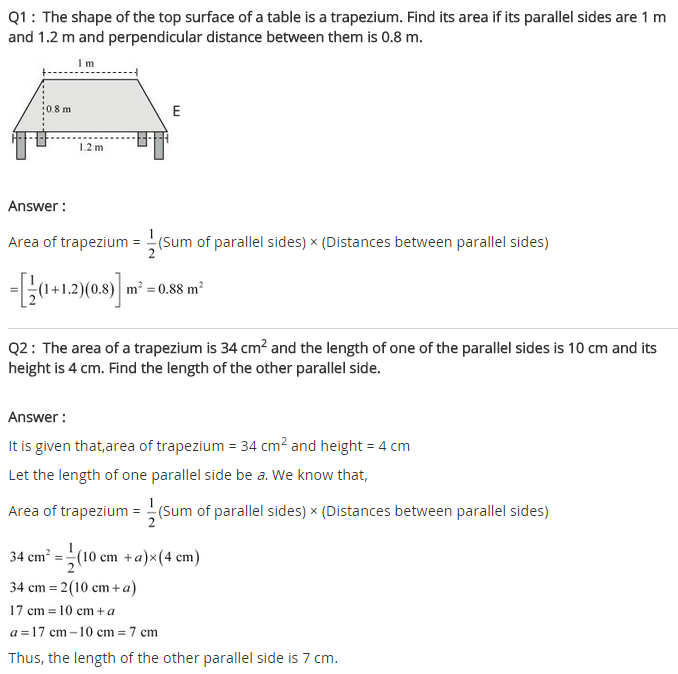
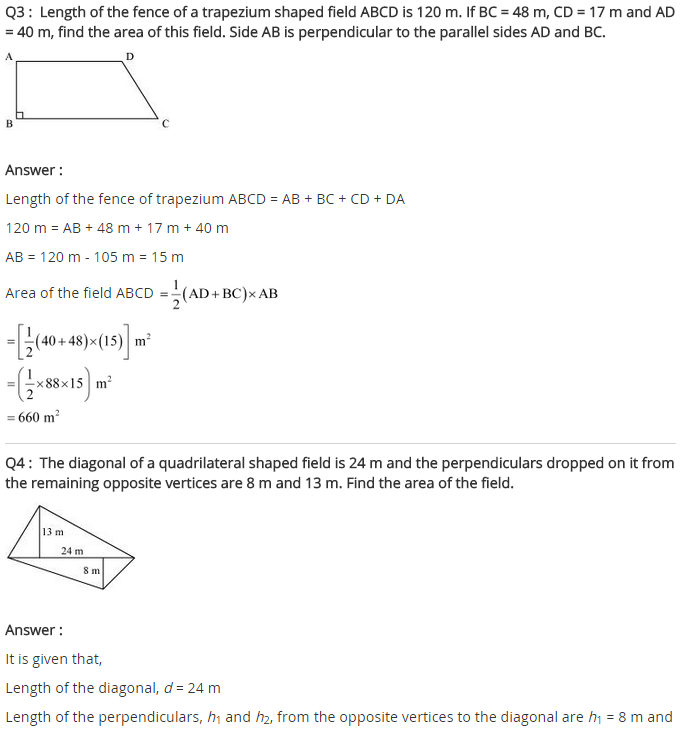
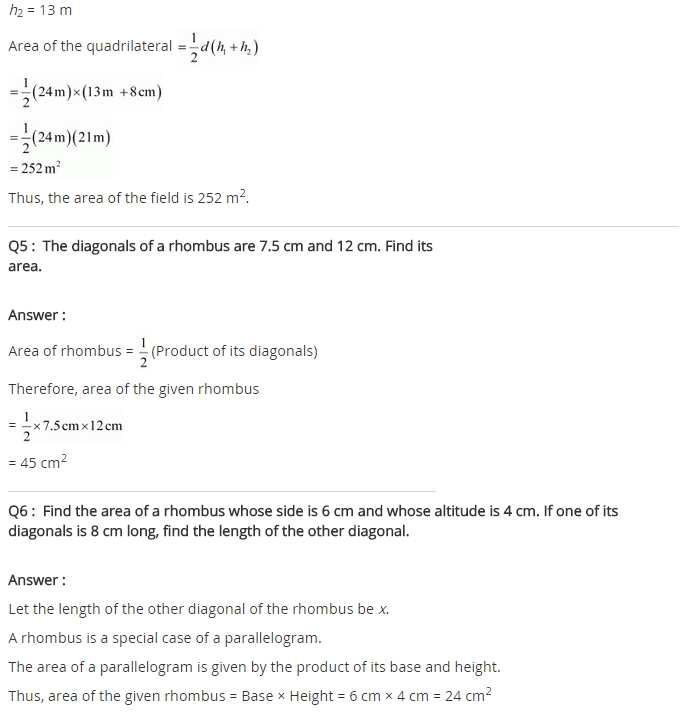
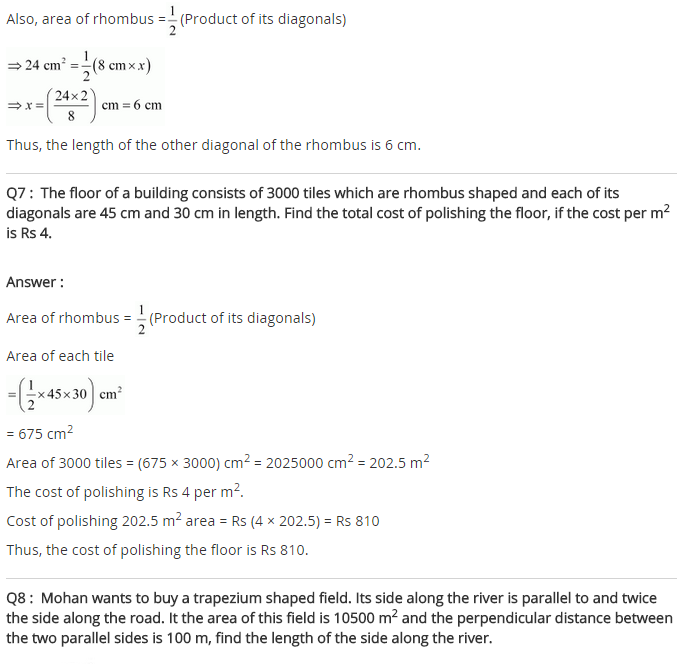
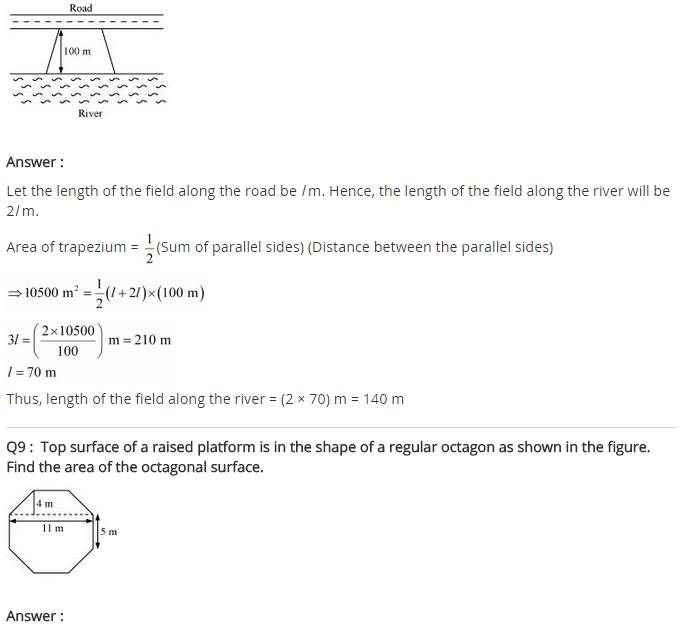
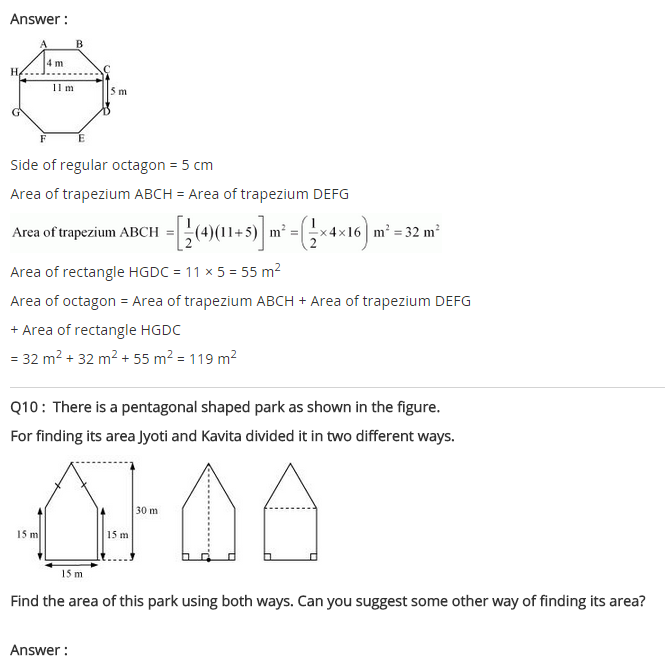
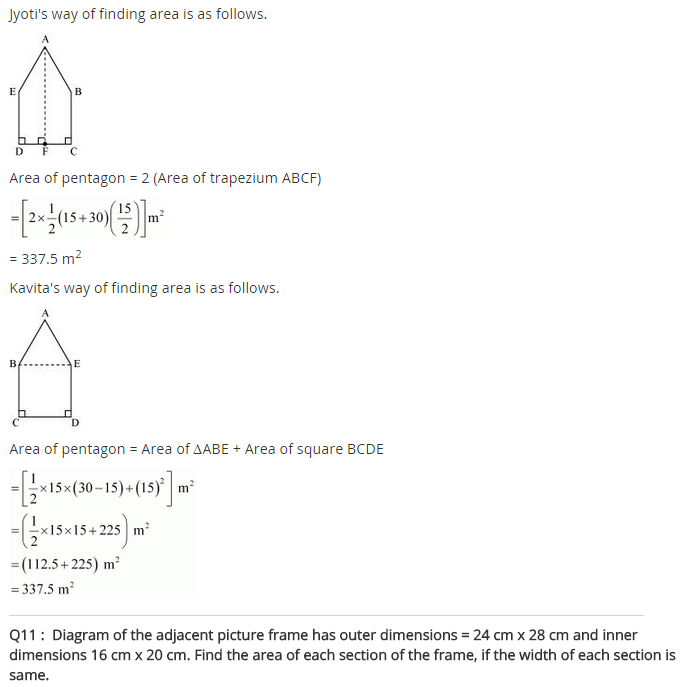
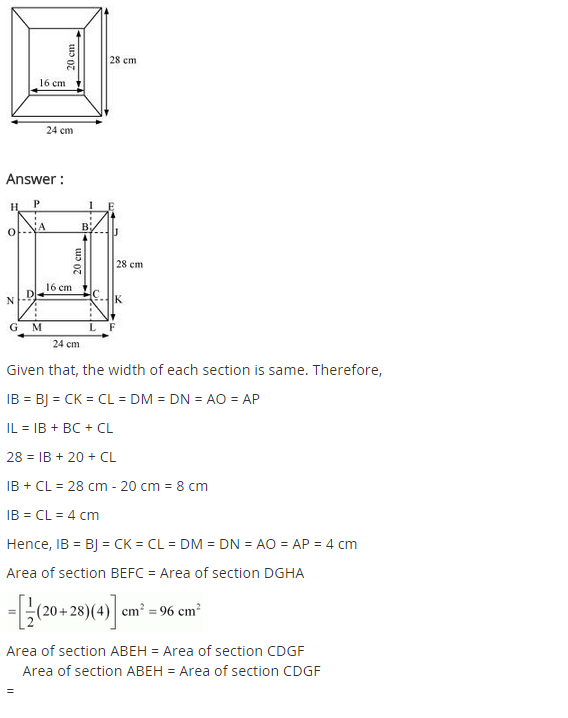
NCERT Solutions for Class 8 Maths Chapter 11 Mensuration Exercise 11.3
Ex 11.3 Class 8 Maths Question 1.
There are two cuboidal boxes as shown in the figure. Which box requires the lesser amount of material to make?
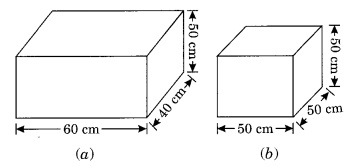
Solution:
(a) Volume of the cuboid = l × b × h = 60 × 40 × 50 = 120000 cm3
(b) Volume of cube = (Side)3 = (50)3 = 50 × 50 × 50 = 125000 cm3
Cuboidal box (a) requires lesser amount of material.
Ex 11.3 Class 8 Maths Question 2.
A suitcase with measures 80 cm × 48 cm × 24 cm is to be covered with a tarpaulin cloth. How many metres of tarpaulin of width 96 cm is required to cover 100 such suitcases?
Solution:
Measurement of the suitcase = 80 cm × 48 cm × 24 cm
l = 80 cm, b = 48 cm and h = 24 cm
Total surface area of the suitcase = 2[lb + bh + hl]
= 2 [80 × 48 + 48 × 24 + 24 × 80]
= 2 [3840 + 1152 + 1920]
= 2 × 6912
= 13824 cm2
Area of tarpaulin = length × breadth = l × 96 = 96l cm2
Area of tarpaulin = Area of 100 suitcase
96l = 100 × 13824
l = 100 × 144 = 14400 cm = 144 m
Hence, the required length of the cloth = 144 m.
Ex 11.3 Class 8 Maths Question 3.
Find the side of a cube whose surface area is 600 cm2?
Solution:
Total surface area of a cube = 6l2
6l2 = 600
l2 = 100
l = √100 = 10 cm
Hence, the required length of side = 10 cm.
Ex 11.3 Class 8 Maths Question 4.
Rukhsar painted the outside of the cabinet of measure 1 m × 2 m × 1.5 m. How much surface area did she cover if she painted all except the bottom of the cabinet?
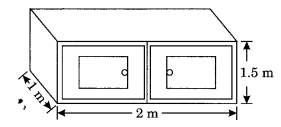
Solution:
l = 2 m, b = 1.5 m, h = 1 m
Area of the surface to be painted = Total surface area of box – Area of base of box
= 2 [lb + bh + hl] – lb
= 2[2 × 1.5 + 1.5 × 1 + 1 × 2] – 2 × 1
= 2[3 + 1.5 + 2] – 2
= 2[6.5] – 2
= 13 – 2
= 11 m2
Hence, the required area = 11 m2.
Ex 11.3 Class 8 Maths Question 5.
Daniel is painting the walls and ceiling of a cuboidal hall with length, breadth and height of 15 m, 10 m and 7 m respectively. From each can of paint 100 m2 of the area is painted. How many cans of paint will she need to paint the room?
Solution:
Surface area of a cuboidal hall without bottom = Total surface area – Area of base
= 2 [lb + bh + hl] – lb
= 2 [15 × 10 + 10 × 7 + 7 × 15] – 15 × 10
= 2[150 + 70 + 105] – 150
= 2 [325] – 150
= 650 – 150
= 500 m2
Area of the paint in one can = 100 m2
Number of cans required = 500100 = 5 cans.
Ex 11.3 Class 8 Maths Question 6.
Describe how the two figures at the right are alike and how they are different. Which box has a larger lateral surface area?
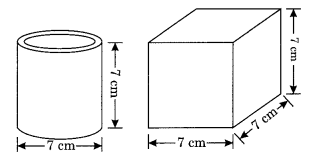
Solution:
The two figures given are cylinder and cube.
Both figures are alike in respect of their same height.
Cylinder: d = 1 cm, h = 7 cm
Cube: Length of each side a = 7 cm
Both of the figures are different in respect of their shapes.
Lateral surface of cylinder = 2πrh
= 2 × 227 × 72 × 7 = 154 cm2
Lateral surface of the cube = 4l2 = 4 × (7)2 = 4 × 49 = 196
So, cube has the larger lateral surface = 196 cm2.
Ex 11.3 Class 8 Maths Question 7.
A closed cylindrical tank of radius 7 m and height 3 m is made from a sheet of metal. How many sheets of metal is required?
Solution:
Area of metal sheet required = Total surface area of the cylindrical tank = 2πr(h + r)
= 2 × 227 × 7(3 + 7)
= 2 × 227 × 7 × 10
= 440 m2
Hence, the required area of sheet = 440 m2.
Ex 11.3 Class 8 Maths Question 8.
The lateral surface area of a hollow cylinder is 4224 cm2. It is cut along its height and formed a rectangular sheet of width 33 cm. Find the perimeter of the rectangular sheet.
Solution:
Width of the rectangular sheet = Circumference of the cylinder
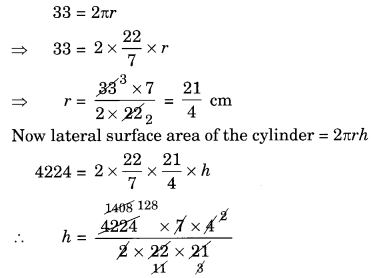
h = 128 cm
l = 128 cm, b = 33 cm
Perimeter of the sheet = 2(l + b) = 2(128 + 33) = 2 × 161 = 322 cm
Hence, the required perimeter = 322 cm.
Ex 11.3 Class 8 Maths Question 9.
A road roller takes 750 complete revolutions to move once over to level a road. Find the area of the road if the diameter of a road roller is 84 cm and length is 1 m.
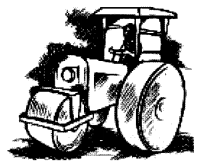
Solution:
The lateral surface area of the road roller = 2πrh
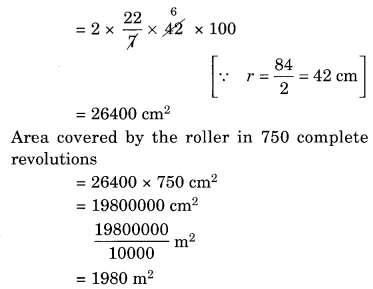
Hence, the area of road = 1980 m2
Ex 11.3 Class 8 Maths Question 10.
A company packages its milk powder in a cylindrical container whose base has a diameter of 14 cm and height 20 cm. The company places a label around the surface of the container (as shown in the figure). If the label is placed 2 cm from top and bottom, what is the area of the label?
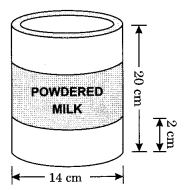
Solution:
Here, r = 142 = 7 cm
Height of the cylindrical label = 20 – (2 + 2) = 16 cm
Surface area of the cylindrical shaped label = 2πrh
= 2 × 227 × 7 × 16
= 704 cm2
Hence, the required area of label = 704 cm2.
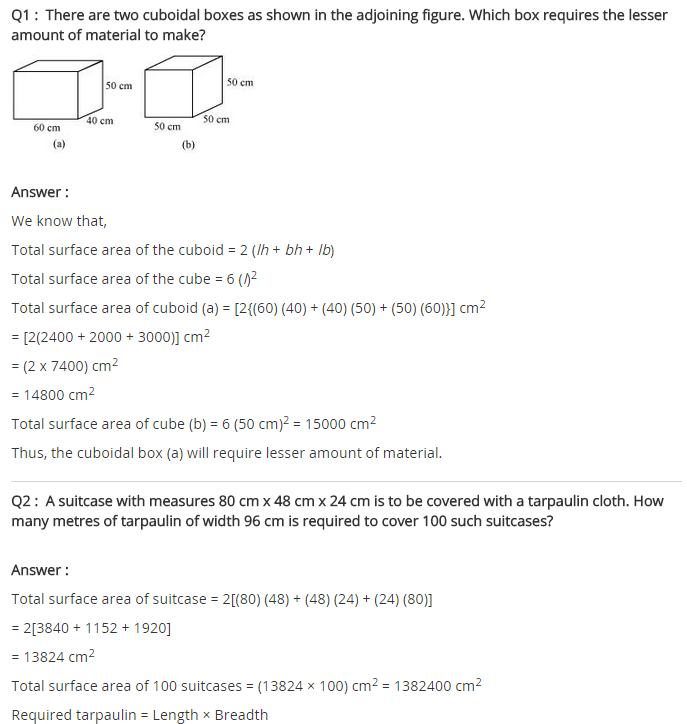
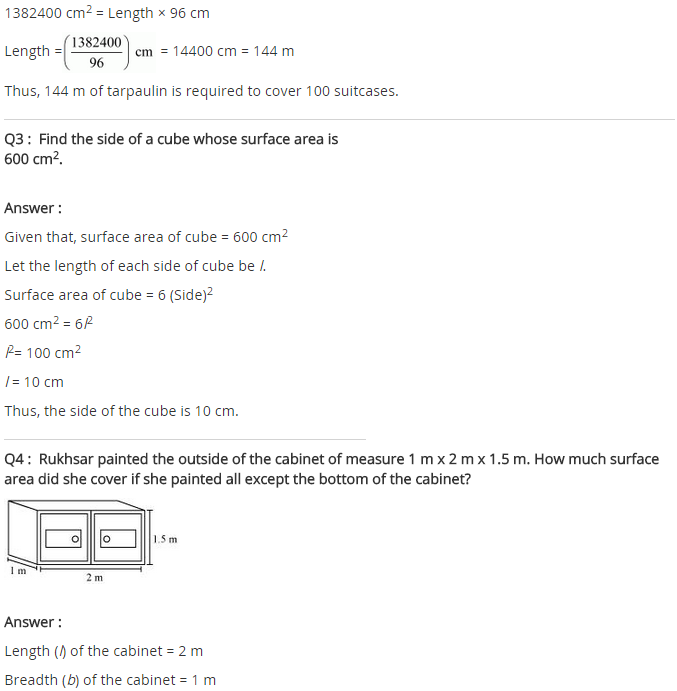
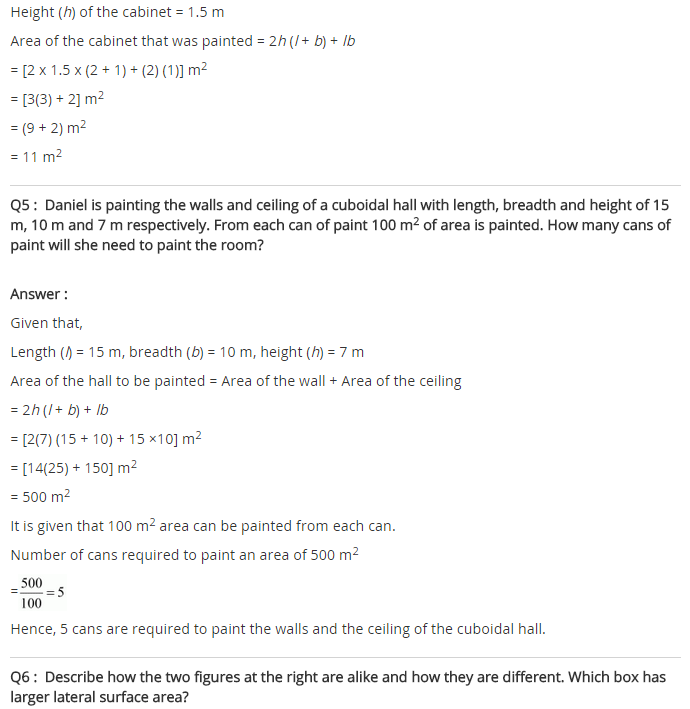
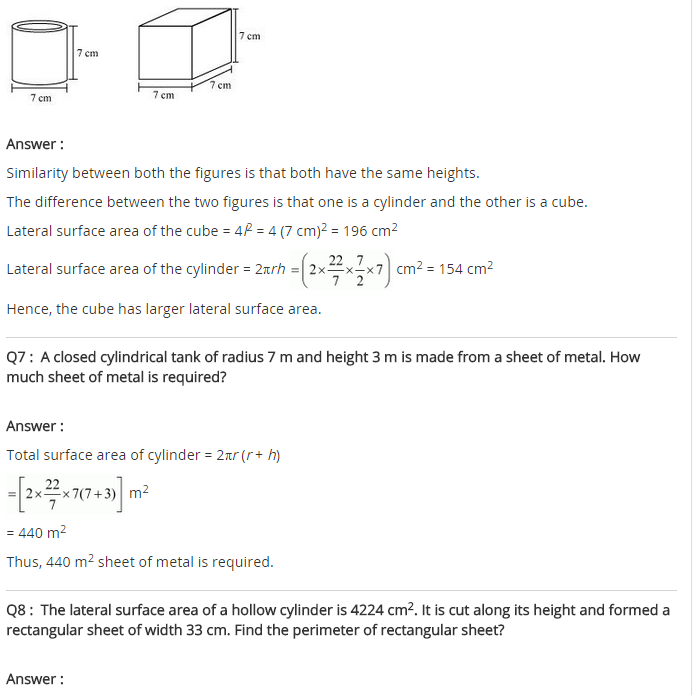
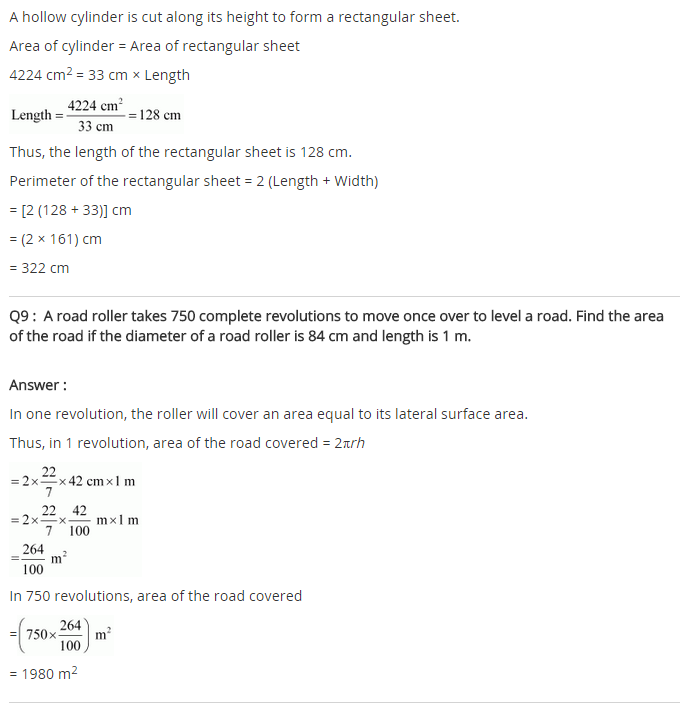
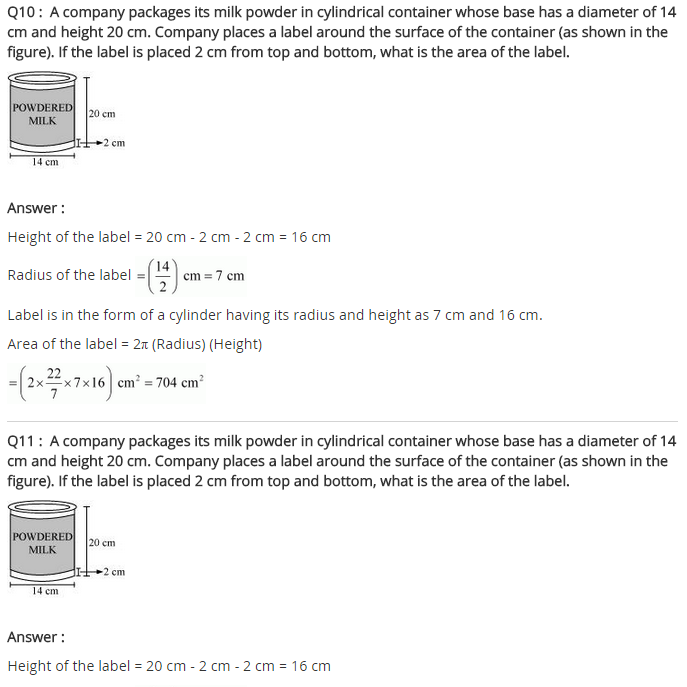

NCERT Solutions for Class 8 Maths Chapter 11 Mensuration Exercise 11.4
Ex 11.4 Class 8 Maths Question 1.
Given a cylindrical tank, in which situation will you find the surface area and in which situation volume.
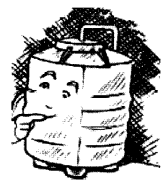
(a) To find how much it can hold.
(b) Number of cement bags required to plaster it.
(c) To find the number of smaller tanks that can be filled with water from it.
Solution:
(a) In this situation, we can find the volume.
(b) In this situation, we can find the surface area.
(c) In this situation, we can find the volume.
Ex 11.4 Class 8 Maths Question 2.
Diameter of cylinder A is 7 cm, and the height is 14 cm. Diameter of cylinder B is 14 cm and height is 7 cm. Without doing any calculations can you suggest whose volume is greater? Verify it by finding the volume of both the cylinders. Check whether the cylinder with greater volume also has greater surface area?
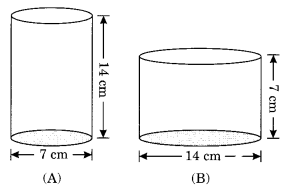
Solution:
Cylinder B has a greater volume.
Verification:
Volume of cylinder A = πr2h
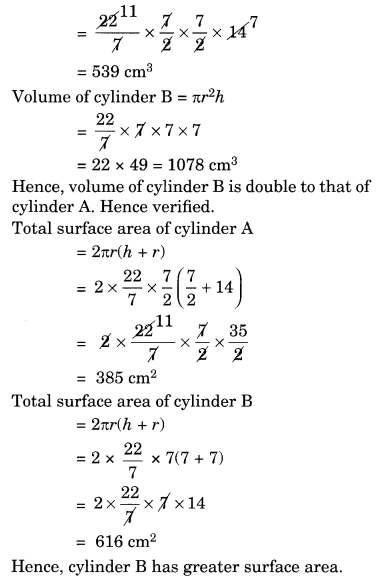
Ex 11.4 Class 8 Maths Question 3.
Find the height of a cuboid whose base area is 180 cm2 and volume is 900 cm3.
Solution:
Given: Area of base = lb = 180 cm2
V = 900 cm3
Volume of the cuboid = l × b × h
900 = 180 × h
h = 5 cm
Hence, the required height = 5 cm.
Ex 11.4 Class 8 Maths Question 4.
A cuboid is of dimensions 60 cm × 54 cm × 30 cm. How many small cubes with side 6 cm can be placed in the given cuboid?
Solution:
Volume of the cuboid = l × b × h = 60 cm × 54 cm × 30 cm = 97200 cm3
Volume of the cube = (Side)3 = (6)3 = 216 cm3
Number of the cubes from the cuboid
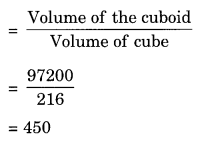
Hence, the required number of cubes = 450.
Ex 11.4 Class 8 Maths Question 5.
Find the height of the cylinder whose volume is 1.54 m3 and the diameter of the base is 140 cm.
Solution:
V = 1.54 m3, d = 140 cm = 1.40 m
Volume of the cylinder = πr2h
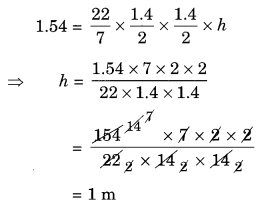
Hence, the height of cylinder = 1 m.
Ex 11.4 Class 8 Maths Question 6.
A milk tank is in the form of a cylinder whose radius is 1.5 m and length is 7 m. Find the quantity of milk in litres that can be stored in the tank.
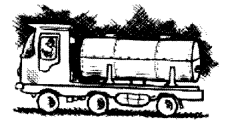
Solution:
Here, r = 1.5 m
h = 7 m
.’. Volume of the milk tank = πr2h
= 227 × 1.5 × 1.5 × 7
= 22 × 2.25
= 49.50 m3
Volume of milk in litres = 49.50 × 1000 L (∵ 1 m3 = 1000 litres)
= 49500 L
Hence, the required volume = 49500 L.
Ex 11.4 Class 8 Maths Question 7.
If each edge of a cube is doubled,
(i) how many times will it be surface area increase?
(ii) how many times will its volume increase?
Solution:
Let the edge of the cube = x cm
If the edge is doubled, then the new edge = 2x cm
(i) Original surface area = 6x2 cm2
New surface area = 6(2x)2 = 6 × 4x2 = 24x2
Ratio = 6x2 : 24x2 = 1 : 4
Hence, the new surface area will be four times the original surface area.
(ii) Original volume of the cube = x3 cm3
New volume of the cube = (2x)3 = 8x3 cm3
Ratio = x3 : 8x3 = 1 : 8
Hence, the new volume will be eight times the original volume.
Ex 11.4 Class 8 Maths Question 8.
Water is pouring into a cuboidal reservoir at the rate of 60 litres per minute. If the volume of the reservoir is 108 m3, find the number of hours it will take to fill the reservoir.
Solution:
Volume of the reservoir = 108 m3 = 108000 L [∵1 m3 = 1000 L]
Volume of water flowing into the reservoir in 1 minute = 60 L
Time taken to fill the reservoir
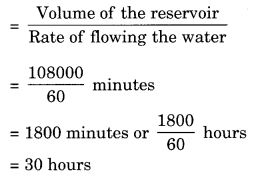
Hence, the required hour to fill the reservoir = 30 hours.
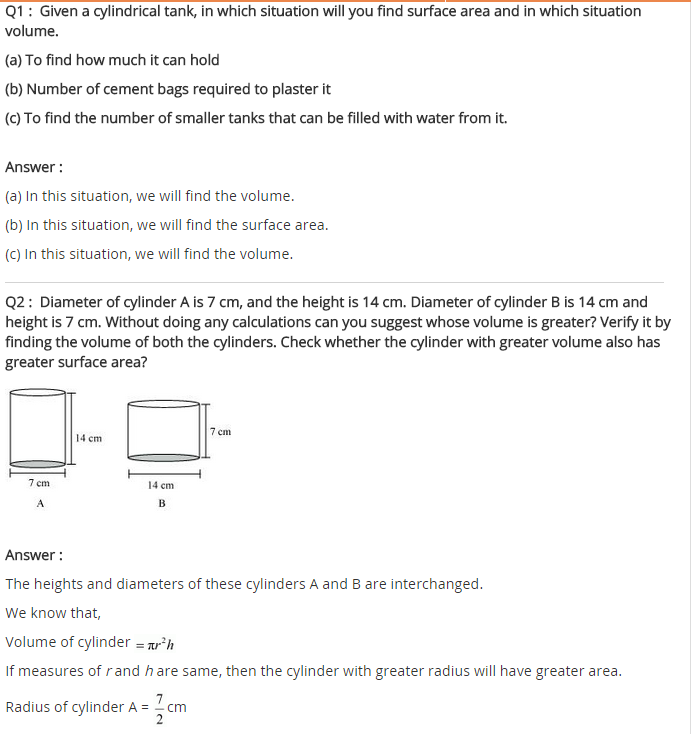
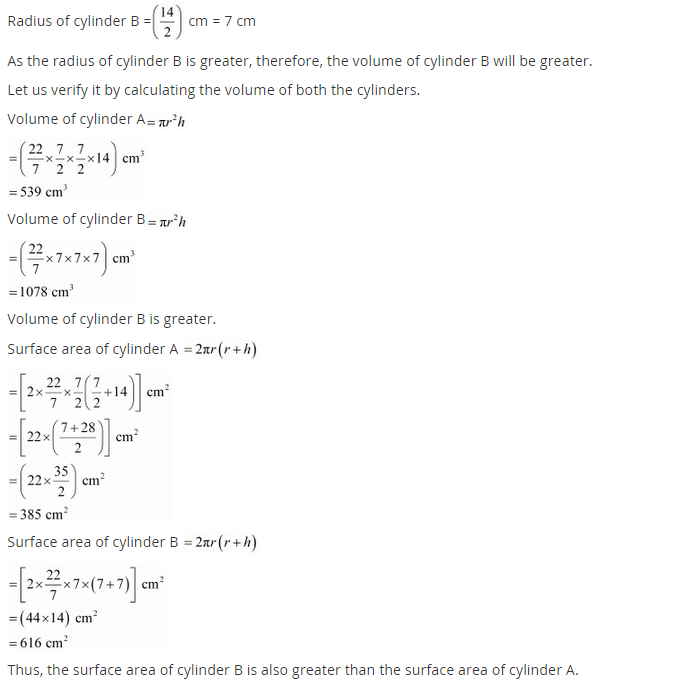
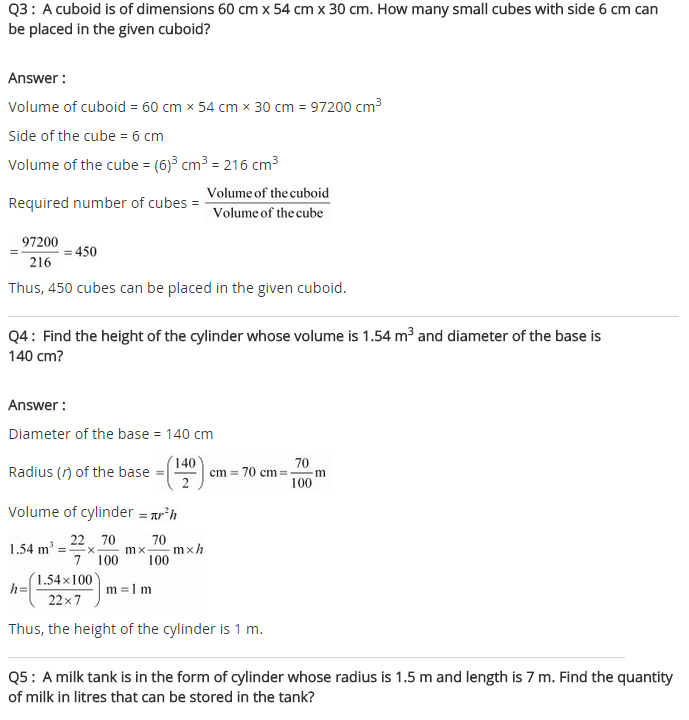
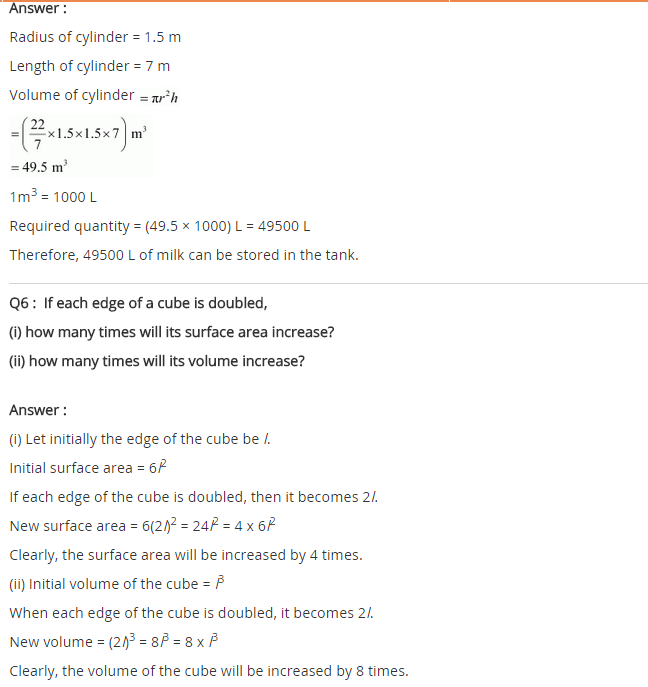
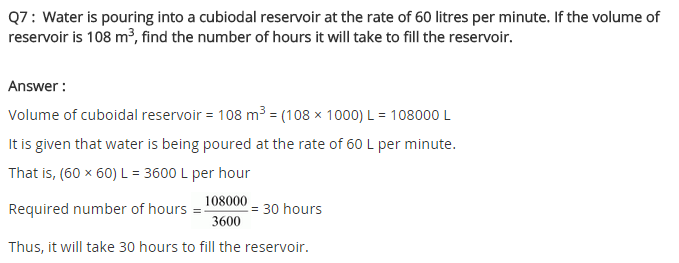
Mensuration Class 8 Extra Questions Maths Chapter 11
Extra Questions for Class 8 Maths Chapter 11 Mensuration
Mensuration Class 8 Extra Questions Very Short Answer Type
Question 1.
Find the perimeter of the following figures:

Solution:
(i) Perimeter of the rectangle = 2(l + b) = 2(8 + 6) = 2 × 14 = 28 cm
(ii) Perimeter of the square = 4 × side = 4 × 6 = 24 cm
(iii) Perimeter of the circle = 2πr = 2 × 227 × 7 = 44 cm.
Question 2.
The length and breadth of a rectangle are 10 cm and 8 cm respectively. Find its perimeter if the length and breadth are (i) doubled (ii) halved.
Solution:
Length of the rectangle = 10 cm
Breadth of the rectangle = 8 cm
(i) When they are doubled,
l = 10 × 2 = 20 cm
and b = 8 × 2 = 16 cm
Perimeter = 2(l + b) = 2(20 + 16) = 2 × 36 = 72 cm
(ii) When they are halved,
l = 102 = 5 cm
b = 82 = 4 cm
Perimeter = 2(l + b) = 2(5 + 4) = 2 × 9 = 18 cm
Question 3.
A copper wire of length 44 cm is to be bent into a square and a circle. Which will have a larger area?
Solution:
(i) When the wire is bent into a square.
Side = 444 = 11 cm
Area of the square = (side)2 = (11)2 = 121 cm2
(ii) When the wire is bent into a circle.
Circumference = 2πr
44 = 2πr

So, the circle will have a larger area.
Question 4.
The length and breadth of a rectangle are in the ratio 4 : 3. If its perimeter is 154 cm, find its length and breadth.
Solution:
Let the length of the rectangle be 4x cm and that of breadth = 3x cm
Perimeter = 2(l + b) = 2(4x + 3x) = 2 × 7x = 14x cm
14x = 154
x = 11
Length = 4 × 11 = 44 cm
and breadth = 3 × 11 = 33 cm
Question 5.
The area of a rectangle is 544 cm2. If its length is 32 cm, find its breadth.
Solution:
Area = 544 cm2
Length = 32 cm
Breadth of the rectangle = AreaLength
= 54432
= 17 cm
Hence, the required breadth = 17 cm
Question 6.
If the side of a square is doubled then how much time its area becomes?
Solution:
Let the side of the square be x cm.
Area = (side)2 = x2 sq. cm
If its side becomes 2x cm then area = (2x)2 = 4x2 sq. cm
Ratio is x2 : 4x2 = 1 : 4
Hence, the area would become four times.
Question 7.
The areas of a rectangle and a square are equal. If the length of the rectangle is 16 cm and breadth is 9 cm, find the side of the square.
Solution:
Area of the square = Area of the rectangle = 16 × 9 = 144 cm2
Side of the square = √Area of the square = √144 = 12 cm
Hence, the side of square = 12 cm.
Question 8.
If the lengths of the diagonals of a rhombus are 16 cm and 12 cm, find its area.
Solution:
Given:
First diagonal d1 = 16 cm
Second diagonal d2= 12 cm

Hence, the required area = 96 cm2.
Question 9.
The area of a rhombus is 16 cm2. If the length of one diagonal is 4 cm, find the length of the other diagonal.
Solution:
Given: Area of the rhombus = 16 cm2
Length of one diagonal = 4 cm

Hence, the required length = 8 cm.
Question 10.
If the diagonals of a rhombus are 12 cm and 5 cm, find the perimeter of the rhombus.
Solution:
Given: d1 = 12 cm, d2 = 5 cm


The perimeter = 4 × side = 4 × 6.5 = 26 cm
Hence, the perimeter = 26 cm.
Mensuration Class 8 Extra Questions Short Answer Type
Question 11.
The volume of a box is 13400 cm3. The area of its base is 670 cm2. Find the height of the box.
Solution:
Volume of the box = 13400 cm3
Area of the box = 670 cm2

Hence, the required height = 20 cm.
Question 12.
Complete the following table; measurement in centimetres.

Solution:


Question 13.
Two cubes are joined end to end. Find the volume of the resulting cuboid, if each side of the cubes is 6 cm.
Solution:

Length of the resulting cuboid = 6 + 6 = 12 cm
Breadth = 6 cm
Height = 6 cm
Volume of the cuboid = l × b × h = 12 × 6 × 6 = 432 cm3
Question 14.
How many bricks each 25 cm by 15 cm by 8 cm, are required for a wall 32 m long, 3 m high and 40 cm thick?
Solution:
Converting into same units, we have,
Length of the wall = 32 m = 32 × 100 = 3200 cm
Breadth of the wall = 3 m = 3 × 100 = 300 cm
and the height = 40 cm
v, length of the brick = 25 cm
breadth = 15 cm
and height = 8 cm
Number of bricks required

Hence, the required number of bricks = 12800.
Question 15.
MNOPQR is a hexagon of side 6 cm each. Find the area of the given hexagon in two different methods.

Solution:
Method I: Divide the given hexagon into two similar trapezia by joining QN.

Area of the hexagon MNOPQR = 2 × area of trapezium MNQR
= 2 × 12 (6 + 11) × 4
= 17 × 4
= 68 cm2
Method II: The hexagon MNOPQR is divided into three parts, 2 similar triangles and 1 rectangle by joining MO, RP.

Question 16.
The area of a trapezium is 400 cm2, the distance between the parallel sides is 16 cm. If one of the parallel sides is 20 cm, find the length of the other side.
Solution:
Given: Area of trapezium = 400 cm2
Height = 16 cm

Hence, the required length = 30 cm.
Question 17.
Find the area of the hexagon ABCDEF given below. Given that: AD = 8 cm, AJ = 6 cm, AI – 5 cm, AH = 3 cm, AG = 2.5 cm and FG, BH, EI and CJ are perpendiculars on diagonal AD from the vertices F, B, E and C respectively.

Solution:
Given:
AD = 8 cm
FG = 3 cm
AJ = 6 cm
EI = 4 cm
AI = 5 cm
BH = 3 cm
AH = 3 cm
CJ = 2 cm
AG = 2.5 cm



Area of hexagon ABCDEF = Area of ΔAGF + Area of trapezium FGIE + Area of ΔEID + Area of ΔCJD + Area of trapezium HBCJ + Area of ΔAHB
= 3.75 cm2 + 8.75 cm2 + 6 cm2 + 2 cm2 + 7.5 cm2 + 4.5 cm2
= 32.50 cm2.
Question 18.
Three metal cubes of sides 6 cm, 8 cm and 10 cm are melted and recast into a big cube. Find its total surface area.
Solution:
Volume of the cube with side 6 cm = (side)3 = (6)3 = 216 cm3
Volume of the cube with side 8 cm = (side)3 = (8)3 = 512 cm3
Volume of the cube with side 10 cm = (side)3 = (10)3 = 1000 cm3
Volume of the big cube = 216 cm3 + 512 cm3 + 1000 cm3 = 1728 cm3
Side of the resulting cube = 1728−−−−√3 = 12 cm
Total surface area = 6 (side)2 = 6(12)2 = 6 × 144 cm2 = 864 cm2.
Question 19.
The diameter of a roller is 84 cm and its length is 120 cm. It takes 500 complete revolutions to move once over to level a playground. Find the area of the playground in m2.
Solution:
Given: Diameter of the roller = 84 cm
Radius = 842 = 42 cm
Height = 120 cm
Curved surface area of the roller = 2πrh

Area covered by the roller in one complete revolution = 3.168 m2
Area covered in 500 complete revolutions = 500 × 3.168 = 1584 m2
Hence, the required area = 1584 m2.
Question 20.
A rectangular metal sheet of length 44 cm and breadth 11 cm is folded along its length to form a cylinder. Find its volume.
Solution:
Circumference of the base = 2πr

= 423.5 cm3
Hence, the required volume = 423.5 cm3.
Question 21.
160 m3 of water is to be used to irrigate a rectangular field whose area is 800 m2. What will be the height of the water level in the field? (NCERT Exemplar)
Solution:
Volume of water = 160 m3
Area of rectangular field = 800 m2
Let h be the height of water level in the field.
Now, the volume of water = volume of cuboid formed on the field by water.
160 = Area of base × height = 800 × h
⇒ h = 0.2
So, required height = 0.2 m
Question 22.
Find the area of a rhombus whose one side measures 5 cm and one diagonal as 8 cm. (NCERT Exemplar)
Solution:
Let ABCD be the rhombus as shown below.

DO = OB = 4 cm, since diagonals of a rhombus are perpendicular bisectors of each other.
Therefore, using Pythagoras theorem in ΔAOB, AO2 + OB2 = AB2

Question 23.
The parallel sides of a trapezium are 40 cm and 20 cm. If its non-parallel sides are both equal, each being 26 cm, find the area of the trapezium.
Solution:
Let ABCD be the trapezium such that
AB = 40 cm and CD 20 cm and AD = BC = 26 cm.

Now, draw CL || AD
Then ALCD is a parallelogram.
So AL = CD = 20 cm
and CL = AD = 26 cm.
In ΔCLB, we have CL = CB = 26 cm
Therefore, ΔCLB is an isosceles triangle.
Draw altitude CM of ΔCLB.
Since ΔCLB is an isosceles triangle. So, CM is also the median.
Then LM = MB = 12 BL = 12 × 20 cm = 10 cm
[as BL = AB – AL = (40 – 20) cm = 20 cm].
Applying Pythagoras theorem in ΔCLM, we have
CL2 = CM2 + LM2
262 = CM2 + 102
CM2 = 262 – 102 = (26 – 10) (26 + 10) = 16 × 36 = 576
CM = √576 = 24 cm
Hence, the area of the trapezium = 12 (sum of parallel sides) × height
= 12 (20 + 40) × 24
= 30 × 24
= 720 cm2.
Question 24.
Find the area of polygon ABCDEF, if AD = 18 cm, AQ = 14 cm, AP = 12 cm, AN = 8 cm, AM = 4 cm, and FM, EP, QC and BN are perpendiculars to diagonal AD. (NCERT Exemplar)
Solution:

In the figure
MP = AP – AM = (12 – 4) cm = 8 cm
PD = AD – AP = (18 – 12) cm = 6 cm
NQ = AQ – AN = (14 – 8) cm = 6 cm
QD = AD – AQ = (18 – 14) cm = 4 cm
Area of the polygon ABCDEF = area of ∆AFM + area of trapezium FMPE + area of ∆EPD + area of ∆ANB + area of trapezium NBCQ + area of ∆QCD.
















